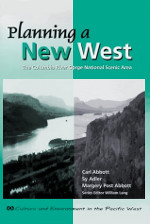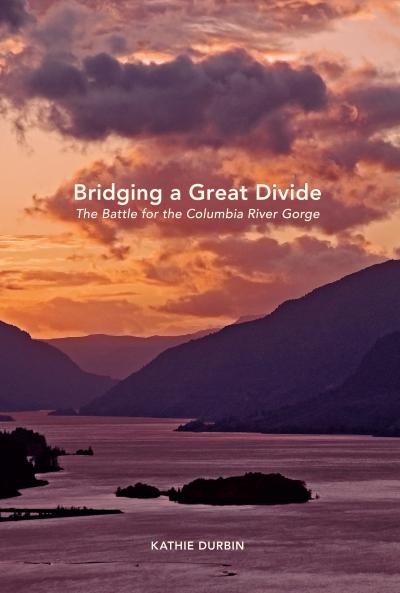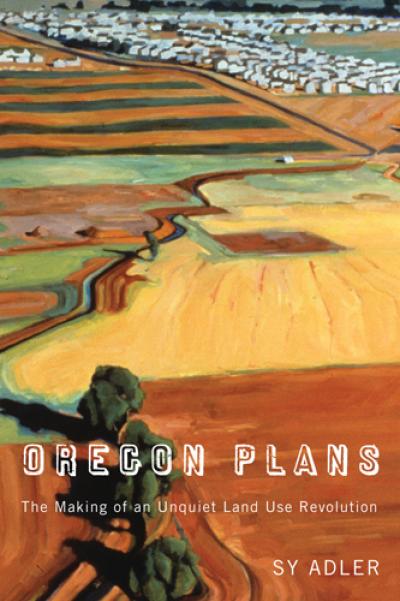
Planning a New West
Sy Adler, Margery Post Abbott, and Carl Abbott
With the recent decline of natural resource industries in the American West, a new economic future has dawned for the region, focused on tourism, service industries, and high technology. Affluent and articulate interests are shaping a New West on the foundations of the Old West, often against the wishes of some local residents. As former timber, farming, and mining landscapes are re-allocated for recreation, tourist facilities, environmental protection, and new residential development, the debate over who gets to shape and speak for the West intensifies. In the Columbia Gorge, the creation of a National Scenic Area in 1986 enjoined differences between the goals and values of the Old and New Wests.
In Planning a New West the authors present a fast-paced account of the creation of the Columbia River Gorge National Scenic Area. As the nation's first multi-entity national scenic area — a regional land use planning effort mandated by the federal government in partnership with state and local governments — the Columbia River Gorge National Scenic Area is a revealing case study that explores what may be the future for protection of historical landscapes in the American West.
Planning a New West explains the political battles over the future of the Gorge, including environmentalist concerns about logging, local property owners' worries about increasing population, and the invasion of windsurfers and other recreationalists. The authors describe the range of viewpoints and the disputes that raged between contending groups trying to shape the legislation. Finally, the book covers the legislation itself and examines what has been accomplished in the ten years since its passage.
Throughout this volume, the authors address a key question: what happens when a coveted landscape becomes a battleground for two legitimate and compelling visions of the American West? In examining the origins and implementations of the Columbia River Gorge National Scenic Area, Planning a New West reveals a vast experiment in mediating between old and new.
About the author
Sy Adler has been researching and writing about various aspects of urban and regional planning in Oregon and Portland since 1982, when he arrived to teach at Portland State University, drawn in part because of the innovative city and regional plans and state initiatives that had been adopted and implemented. He is currently interim dean of the College of Urban and Public Affairs at Portland State University.
Read more about this author
Margery Post Abbott is a writer and researcher in Portland, Oregon.
Read more about this author
Carl Abbott is emeritus professor of urban studies and planning at Portland State University. He is the author of many articles and books, including How Cities Won the West: Four Centuries of Urban Change in Western North America and several about Portland history, including Portland: Planning, Politics, and Growth in a Twentieth Century City; The Great Extravaganza: Portland’s Lewis and Clark Exposition; and Greater Portland: Urban Life and Landscape in the Pacific Northwest.
Read more about this author
Series Editor's Introduction
Introducing the Columbia River Gorge: "Magnificent Display and Terrible Grandeur"
- Portland's "Private Elysium"
- From Trading Posts to Tourism: The Gorge Economy in Transition
- Choosing Sides
- The Politics of Protection
- Making a Management Plan
- Testing the Waters: From Plan to Action
- Whose Gorge Is It?
Sources
Notes
Index
The American West in the late twentieth century looks dramatically different than it did a century ago. Most of what has happened to the environment at the behest of an expanding national economy and a technologically ambitious population still lay ahead when the young Frederick Jackson Turner delivered his famous address at the Chicago World's Fair in 1893. Few predicted exactly how important the American West would be in the coming century and even fewer foresaw the potential for environmental crises that so worries this generation of westerners. Prognostications for the coming Century by experts in 1893 included everything from recognition of a full range of women's rights and universal access to electricity to the institution of an international currency and 100-mile-per-hour trains. None of the 74 futurists at the World's Fair mentioned environmental issues. Yet today that subject is primary to scholars and thinkers about the American West, because of the enormous changes visited on the landscape during this century. And it is a more-than-even bet that the twenty-first century's central conundrums will concern the environment and human activity.
Awareness of contemporary environmental issues and the need to understand the historical relationships between humans and their environment prompts this series in Culture and Environment in the Pacific West. Its central focus is what happens when human cultural inventions intersect with the non-human world. Scholars have long agreed that investigations of environmental questions cannot be divorced from the context and ideology that inform and motivate human activity. likewise, modern thinkers consider it delusionary to attempt explanations of human behavior apart from environmental conditions and places. But explanations of these relationships are nothing if not complex, and the resulting texts often read as very technical and arcane treatises. That is unfortunate, because the issues inherent in studies of human interaction with the environment are important and deserve consideration by a thoughtful public. With that purpose in mind, Culture and Environment in the Pacific West will publish books that broadly and creatively investigate the diverse relationships between human communities and their environments in the country west of the Continental Divide, a spectacularly varied and contrapuntal region of aridity and rivers, high plains and coastal slope, canyon lands and seashore.
Cultural diversity among human communities in the Pacific West has matched the region's environmental heterogeneity. From the earliest documented indigenous cultures to the most recent migrants, the Pacific West's people have found their places in the region, sometimes in areas with ready sustenance at hand and sometimes in environments that test human ingenuity. The stories of how they create their places in the large environment and what that means to their neighbors and subsequent generations are the prime subjects of this series. These narratives are about change in the environment and in the ways people have furthered the human enterprise. The accounts are neither entirely harmonious nor discordant but always revealing about how western people have understood their place. The profound changes that everywhere in the Pacific West seem to signify a crucial reorientation in how people relate to the environment and how they perceive their past is captured in the term "New West," which is generally understood to mean a broad range of new relationships between economic activity and western landscapes, between residents and new settlers, and between orientations that are labeled "Old West" and "New West" is the subject of the inaugural book in the series.
In Planning a New West, Carl Abbott, Sy Adler, and Margery Post Abbott investigate the reinvention of a classic western landscape — the Columbia River Gorge. Like some of the stories of conflict in the Old West, which pitted competing users of the land against each other, this narrative describes a contest over the management of an environmental place int he New West. It is a complex and fast-paced story that begins with a land use conflict in 1981, devolves into a cultural tug-of-war between competing visions for a dramatically scenic landscape, and concludes with the creation of an ongoing experiment in regional environmental planning that is unique in the Pacific West.
In this masterful telling, the authors take readers inside one of the most remarkable planning efforts in recent history, perhaps a harbinger of future resolutions of similar environmental disputes. Planning a New West is fundamentally about the process of understanding the multifarious connections people have with place and the inescapable conflict when the participants disagree. In the Columbia Gorge, an 18511-acre riverine environment dominated by the powerful Columbia River, breathtaking waterfalls, dense forests, and small communities, the Old West met the New West during the past two decades, when windsurfers discovered the gorge winds, traditional natural resource industries tumbled, and urban emigrants began resettling the place as a recreational area. No single conflict between the new and old residents or between the newer and older economies could be settled, the authors explaining, without everyone contending with the environmental power of the gorge itself.
The authors carefully detail how the participants found their way out of an environmental and cultural dilemma by reinventing the place. Yet in the reinvention, as Planning a New West makes clear, the residents and planners reached back into the earlier visions of the gorge — even to those expressed by Native Americans — to craft a new understanding and foundation for inhibiting the place. The authors draw no hard-edged conclusions about the process and the results, for the heart of their story is in the creative reinvention that makes up the Columbia River Gorge National Scenic Area. If there truly is a New West, it may well be that this book is the first telling of how it will be organized.
William L. Lang


